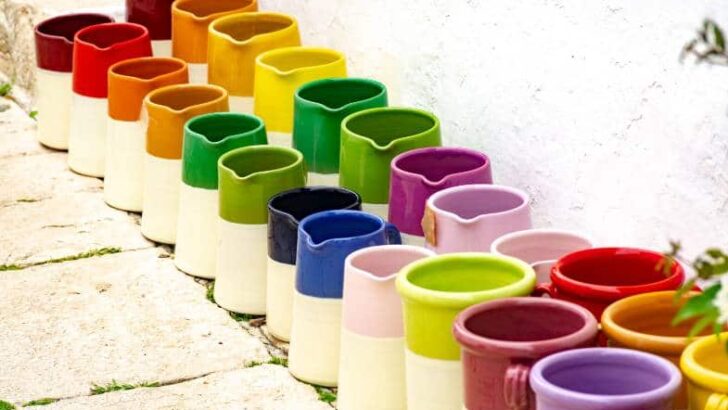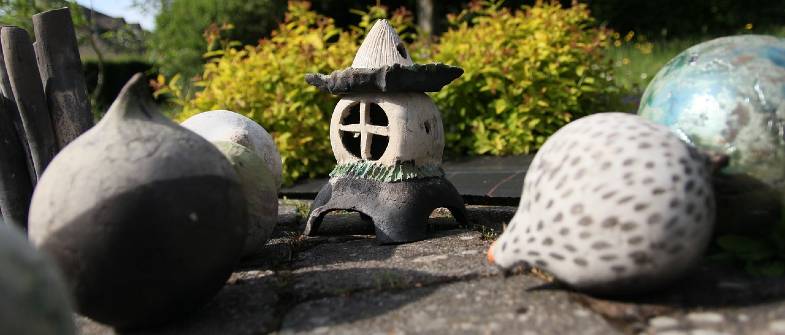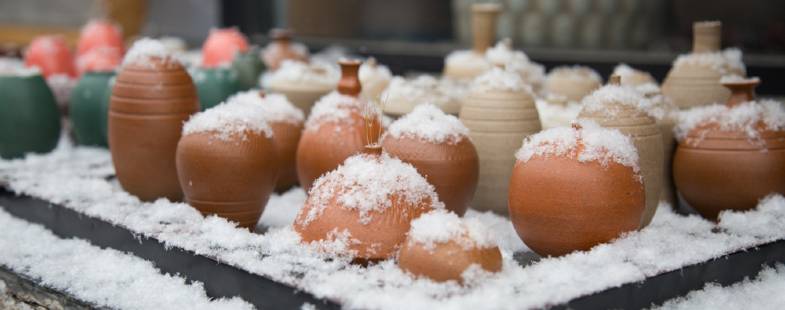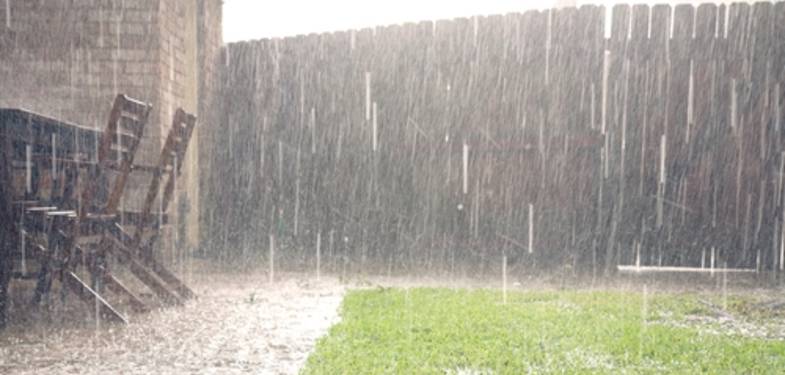Your cart is currently empty!
Can You Keep Your Pottery Outdoors? Protecting Your Pots
Published:
Last Updated:

Affiliate Disclaimer
As an affiliate, we may earn a commission from qualifying purchases. We get commissions for purchases made through links on this website from Amazon and other third parties.
Pottery and sculpture can be a beautiful addition to an outside space. However outdoor conditions are not ideal for fired clay. Factors like heat, cold, rain, etc can affect your pottery resulting in wear and tear. So, should you avoid keeping your pottery outdoors or can they be protected from the effect of the weather?
You can keep your pottery outdoors. However, heat, cold, and water pose difficulties that need consideration if you are to keep your pottery intact. Water is absorbed by porous ceramics and expands when it heats or freezes. This can cause cracks. High fired vitrified ceramics, therefore, survive the elements more successfully.
As well as choosing clay that vitrifies, there are other steps you can take to protect your pottery. Let’s have a look at them now. That way, you will be able to keep your pottery outdoors without having to worry about them being damaged.
Can You Keep Your Pottery Outdoors – The Problem
It’s no surprise that pottery, when exposed to heat, cold, or rain develops signs of wear and tear over time.
Cracks, spalling, flaking, erosion, and salt damage are some of the most common occurrences when you keep your pottery outdoors. For example, fluctuating humidity levels can aggravate the harmful effects of salts in ceramics.
Humidity dissolves the salt and moves it around the ceramic structure. The salt then travels to the surface of the pottery, leaving a tell-tale white crust known as salt efflorescence.
Terracotta, which is porous, is more likely to show signs of cracking when kept out in the cold. Water absorbed into the porous ceramic turns into ice which then expands.
Most pottery, except for ceramics made out of highly vitrified porcelain has some degree of porosity. Pores in clay and other microscopic defects are open structures that allow the free flow of liquid. When exposed to excessive water. For example, if left out in the rain, these pores can act as stress concentrators. This will weaken the integrity of the pottery over time.
In some cases, there might be a manufacturing fault. This can cause cracks to develop in the body of the finished product or crazing in the glaze. This kind of damage most commonly occurs when there are sudden changes in temperature. For example, from direct sunlight or spotlights.
The complications that come with keeping your pottery outdoors can seem a bit too much and a little unsettling. But there are things you can do to protect your pottery. I’ll look at some of these solutions now. So, you can enjoy being able to keep your pottery outdoors without worrying that it will be damaged.

Can You Keep Your Pottery Outdoors – The Solution
Let’s dive into how you can protect your ceramics and keep your pottery outdoors.
Yes, pottery is fragile. It’s prone to a lot of problems if not taken care of well. But that doesn’t mean it can’t take a little beating from being kept outdoors. If you use some of the measures outlined below, your pottery will survive the elements. It may be able to weather the hot sun, freezing cold, and a little splash in the rain.
Protection from The Sun
Before it is fired, clay needs to be dried out to the point of being bone dry. If the firing process starts when the clay is damp there is a danger the pottery will explode. The reason for this is that the moisture in the clay turns to steam at the temperature of boiling water.
As it turns to steam it expands rapidly and enters air pockets and air bubbles in the clay. You can avoid explosions by leaving your clay for long enough to be dry. And also, by candling the kiln before the firing schedule starts.
However, something similar can happen to clay when it is put into strong sunlight. Porous clay that absorbs water can have quite a significant water content. If the sun gradually heats the ceramics, the water has a chance to evaporate.
But if the pottery heats too quickly in strong sun, the water can turn to steam and expand. In its ceramic state, the pottery is rigid. The expanding steam puts the pottery under a lot of stress and can cause the ceramics to crack. Sometimes strong direct sunlight can even have an explosive effect on the pottery, not unlike a kiln.
Other Effects of the Sun on Your Pottery
Sunlight can also cause your pots to fade over time. This is true of unglaze surfaces and glazed surfaces. An unglazed clay can be bleached by the sun as can the colors in a glaze.
Strong sunlight, over a period of time, can also cause adhesives used in restoration to be weakened. Though well-built pottery is generally less sensitive to extremes or fluctuations, all pieces should be treated as if they are potential problem cases.
Therefore, keeping your pottery in direct sunlight is not a great idea. If you want to keep your pottery outdoors it’s best to keep them in the shade away from direct sunlight. This will protect your pottery from extreme fluctuations in temperature. And it will prevent them from fading in the sunlight.
If you know that you are going to keep your pottery outdoors, you can incorporate this into your design. Making your pottery with ‘pot feet’ is a good way to elevate your pottery off the ground. These are decorative feet that keep the base of your pottery away from the soil.
This can help if your soil gets soggy, but also if it heats up as well. Heat can transfer from soil to ceramics. So, preventing your pottery from resting directly on the ground can help. Pot feet also enable air to circulate under your ware.
Protection from The Cold
Pottery and the cold do not go hand in hand. Ceramics, like concrete and other moisture-absorbing materials, are prone to cracking when the temperature dips. This happens because water absorbed into the pot turns into ice below freezing temperatures. As it freezes the ice expands, putting ceramics under pressure and causing them to crack.

Glazed ceramic pots survive the cold better than unglazed terracotta. This is because the glaze creates a non-porous protective surface that repels water.
In addition to glazing, ceramics that have been fired at high temperatures are not as vulnerable to the cold.
If all else fails, you can also protect your pots from frost by moving them against the house. This provides them with some shelter and radiated warmth from the side of your property.
Some people go so far as to take their pottery inside during the winter. If you don’t have enough space inside, you can also wrap them in insulation. Or move them into a greenhouse or shed. This way you can keep your pottery outdoors rather than storing them inside if space is at a premium.
Protection from The Rain
Rain is problematic for pottery. You may have noticed a pattern here! Most of the problems that arise if you keep your pottery outdoors are connected to the presence of water. In porous ceramics, which includes most open-fired wares, water acts as a transporting agent. This allows the chemicals to react with the clay minerals and as a solvent in which many reactions take place.
Pottery that has been fired to higher temperatures will have become vitrified. Vitrification means that some of the materials in the clay body will have turned into glass. The higher the degree of vitrification the less absorbent the pottery will be.
So, high fired clay that has been matured to the point of vitrification will survive the outdoor elements better.

Weatherproofing and sealing will also help protect your pottery from the rain. Some products that are designed to seal the surface of concrete and masonry can help protect ceramic ware too.
But perhaps you would rather not potentially compromise the finish of your pottery with sealants. If that’s the case, then you might be well advised to store your pottery in a shed over the winter.
Just remember that sheds can get damp too. So, it’s a good idea to check that they aren’t sitting in a puddle in your shed too. Or getting moldy in a camp corner.
Can You Keep Your Pottery Outdoors – Final Thoughts
Even though pottery is fragile and can be damaged by the elements, it is still possible to protect it. By following the suggestions mentioned above, you can keep your pottery outdoors in most climates and not worry too much.



